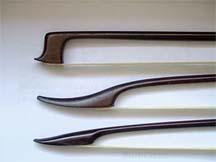Violin Bows
The Violin Bow Through History
 Early stringed instruments were played by primitive cultures worldwide, and were plucked, but not bowed. The practice of bowing probably originated in Central Asia where cave paintings of bowed musical instruments have been found.
Early stringed instruments were played by primitive cultures worldwide, and were plucked, but not bowed. The practice of bowing probably originated in Central Asia where cave paintings of bowed musical instruments have been found.
The early bows were very primitive. The horse hairs were directly fastened to the wood, so their tension could not be adjusted. Because of Central Asia’s proximity to the Silk Road, the bow spread rapidly. The bow was used throughout Islam and the Byzantine Empire.
The bow did not make its way into Europe until the 11th century, but its development remained stagnant until the mid to late 17th century when tension-adjusting mechanisms were added. The shape of the bow transitioned from convex to concave in the late 18th century.
 The pike-type bow head first appeared in the late 1830’s around the time of the death of instrument maker, Stradivari. At that time, the woods used for bow making were iron and snakewood. These were lighter woods that were often fluted to give the bow additional strength and rigidity. For a long time the curvature, or camber of the bow was convex. The camber was changed from convex to concave, the fluted bow and pike’s head were abandoned, and the ferrule was invented.
The pike-type bow head first appeared in the late 1830’s around the time of the death of instrument maker, Stradivari. At that time, the woods used for bow making were iron and snakewood. These were lighter woods that were often fluted to give the bow additional strength and rigidity. For a long time the curvature, or camber of the bow was convex. The camber was changed from convex to concave, the fluted bow and pike’s head were abandoned, and the ferrule was invented.
Antonia Stradivari is acknowledged as having perfected the violin, and Francois Tourte is credited for perfecting the violin bow. He determined the correct proportions of the bow by using mathematics and these proportions remain to this day. His bow had more dynamic range and projection. It also allowed for a greater variety of bowing techniques.
During the mid 19th and 20th centuries in Paris, France modern bow making reached its high-water mark, and became a hub for bow makers aspiring to learn and master the craft.
